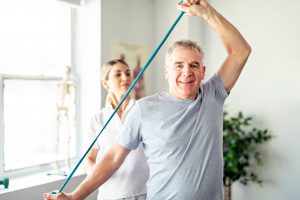– AUGUST 2021 –
 The 3 common mistakes that cause more harm than help in stroke rehabilitation
The 3 common mistakes that cause more harm than help in stroke rehabilitation
When planning the best course of action for suitable rehabilitation exercises for someone recovering from a stroke, it is so important to remember that there is no cookie-cutter solution, where one approach fits all. We all have different, unique brains and no two strokes are the same either.
That being the case, there are three common mistakes that we often see being made in the absence of a specialised neuro physio for stroke patients. Doing any of the following can lead to further damage being caused, as opposed to positively enhancing the healing process:
1. Assuming that the more walking someone who has had a stroke does, the better it is for their recovery. The reality is that there are four elements that need to be carefully considered in order for stroke physiotherapy to be of benefit. Physio must be targeted, specific, repeated and functional. This means repetition of an exercise should be within a functional context, as a way of tapping into the neuroplasticity to improve connections in the brain and body.
2. Focusing on strength only, without simultaneously focusing on developing control of the muscles as well. If a stroke results in causing weakness or paralysis on one side of the body, there can be a significantly varying range of movement, from mild weakness to full paralysis and everything in-between. Rebuilding strength in the arm or leg is one thing but having control over that limb is the ultimate goal. Without having the finer control over the muscles, increasing strength is again going to be of limited benefit.
3. Implementing an exercise program without involving a specialised neuro physio for careful monitoring and adapting the exercises accordingly. A neuro-specialised physio is trained in identifying abnormal movement subtleties that family members and loved ones may have difficulty noticing. This is why it’s crucial to work with a physio who is highly skilled at getting the best out of a therapy session and who pays close attention to how the participant moves, and why an impairment is there. For example, if walking isn’t guided by a neuro physio, all of the person’s bodyweight is being placed on one leg at a time as it makes contact with the ground. The weaker leg will wobble, leading the knee to bend backwards, hyperextending and bouncing around on the knee joint. Over time, this wears out the knee joint as too much pressure is being placed on it. Straining the knee in this way is not normal and causes further damage that could lead to pain, arthritis and potentially not being able to walk at all. Issues in the knees quickly lead to problems in the lower back and hips, as hyper-extending the knee throws the body symmetry out of alignment.
By working with a fully qualified neuro physiotherapist, all of these potential pitfalls will be avoided.
For neuro physiotherapy in Melbourne, we are here to support stroke patients and set them up for success for prolonged health. Please book a free 15-minute consultation with our team here at Active Edge Physio. Alternatively, complete the referral form online and we’ll be in touch within 24 hours (on week days) to explore the best way forward.